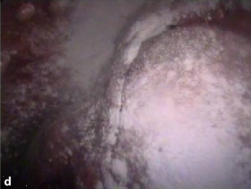Pleurodesis is a medical procedure in which part of the pleural space is artificially obliterated.[1] It involves the adhesion of the visceral and the costal pleura. The mediastinal pleura is spared.
YouTube Encyclopedic
-
1/3Views:28 452178 79437 506
-
Managing Malignant Pleural Effusions: Pleurodesis
-
Pleural Space: Part 3 of 3- Pleural Effusions [HD]
-
Thoracoscopy for Pleurodesis
Transcription
Uses
Pleurodesis is performed to prevent recurrence of spontaneous pneumothorax or pleural effusion, and can be done chemically or mechanically. It is generally avoided in patients with cystic fibrosis if possible, because lung transplantation becomes more difficult following this procedure. Previous pneumothorax with or without pleurodesis is not a contraindication to subsequent lung transplantation.[citation needed]
Chemical
Chemicals such as bleomycin, tetracycline (e.g., minocycline),[2] povidone-iodine, or a slurry of talc can be introduced into the pleural space through a chest drain. The instilled chemicals cause irritation between the parietal and the visceral layers of the pleura which closes off the space between them and prevents further fluid from accumulating.[3] Pharmacy-prepared chemicals for pleurodesis should be clearly labeled "NOT FOR IV ADMINISTRATION"[4] to avoid potentially fatal wrong-site medication errors.[5]
Sterile talc powder, administered intrapleurally via a chest tube, is indicated as a sclerosing agent to decrease the recurrence of malignant pleural effusions in symptomatic patients. It is usually performed at the time of a diagnostic thoracoscopy.[citation needed]
Povidone iodine is equally effective and safe as talc, and may be preferred because of easy availability and low cost.[6]
Chemical pleurodesis is a painful procedure, and so patients are often premedicated with a sedative and analgesics. A local anesthetic may be instilled into the pleural space, or an epidural catheter may be placed for anesthesia.[citation needed]
Surgical
Surgical pleurodesis, also known as mechanical or abrasive pleurodesis, may be performed via thoracotomy or thoracoscopy. This involves mechanically irritating the apical and the costal pleura, often with a scratchpad (a small foam pad with coated abrasive) normally used for cleaning electrocautery blade tips. Moreover, surgical removal of parietal pleura is an effective way of achieving stable pleurodesis.[7]
Alternatively, tunneled pleural catheters (TPCs) may be placed in an outpatient setting and often result in auto-pleurodesis, whereby portable vacuum bottles are used to evacuate the pleural fluid. Routine evacuation keeps the pleura together, resulting in physical agitation by the catheter, which slowly causes the pleura to scar together. This method, though the minimally invasive and minimal cost solution, takes an average of about 30 days to achieve pleurodesis and is therefore the slowest means of achieving pleurodesis among other modalities.[8]
Conservative management of primary spontaneous pneumothorax is noninferior to interventional management, with a lower risk of serious adverse events.[9]
References
- ^ Mohammed Ali; Salim Surani (2020-07-15). "Pleurodesis". StatPearls. PMID 32809520. Archived from the original on 2021-01-28. Retrieved 2021-01-28.
- ^ Chen MD, Chan MD, Tsai MD, Hsu MD, Lin MS, Yuan MD, Prof Chen MD, Prof Lai MD, Prof Yang MD (February 2013). "Simple aspiration and drainage and intrapleural minocycline pleurodesis versus simple aspiration and drainage for the initial treatment of primary spontaneous pneumothorax" (PDF). The Lancet. 381 (9874): 1277–1282. doi:10.1016/S0140-6736(12)62170-9. PMID 23489754. S2CID 18294747. Retrieved 2013-04-04.
- ^ American Thoracic Society (November 2000). "Management of Malignant Pleural Effusions". Am J Respir Crit Care Med. 162 (5): 1987–2001. doi:10.1164/ajrccm.162.5.ats8-00. PMID 11069845. Archived from the original on 2021-11-19. Retrieved 2020-11-16.
- ^ "Sterile Talc Powder For Intrapleural Administration Only". National Library of Medicine. Retrieved 25 June 2014.
- ^ "Fatal intravenous administration of a sterile talc slurry" (PDF). California Department of Public Health, Licensing and Certification Division. Archived (PDF) from the original on 16 February 2017. Retrieved 25 June 2014.
- ^ Das SK, Saha SK, Das A, Halder AK, Banerjee SN, Chakraborty M (September 2008). "A study of comparison of efficacy and safety of talc and povidone iodine for pleurodesis of malignant pleural effusions". J Indian Med Assoc. 106 (9): 589–90, 592. PMID 19552086.
- ^ Sepehripour, Amir H.; Nasir, Abdul; Shah, Rajesh (March 2012). "Does mechanical pleurodesis result in better outcomes than chemical pleurodesis for recurrent primary spontaneous pneumothorax?". Interactive Cardiovascular and Thoracic Surgery. 14 (3): 307–311. doi:10.1093/icvts/ivr094. ISSN 1569-9293. PMC 3290368. PMID 22184464.
- ^ Warren MD, Kim MD, Liptay MD (January 2008). "Identification of clinical factors predicting PleurX catheter removal in patients treated for malignant pleural effusion". European Journal of Cardio-Thoracic Surgery. 33 (1): 89–94. doi:10.1016/j.ejcts.2007.10.002. PMID 17983758.
- ^ Brown, Simon G.A.; Ball, Emma L.; Perrin, Kyle (January 2020). "Conservative versus Interventional Treatment for Spontaneous Pneumothorax". N Engl J Med. 382 (5): 405–415. doi:10.1056/NEJMoa1910775. hdl:10072/396451. PMID 31995686. S2CID 210948660.
External links
 Media related to Pleurodesis at Wikimedia Commons
Media related to Pleurodesis at Wikimedia Commons

